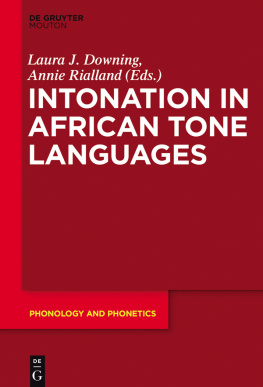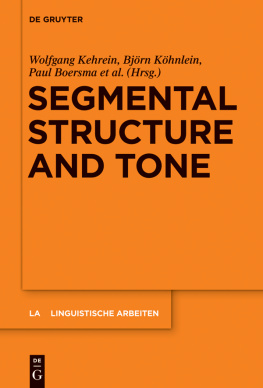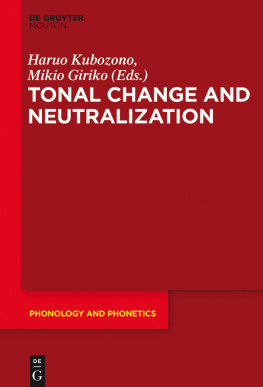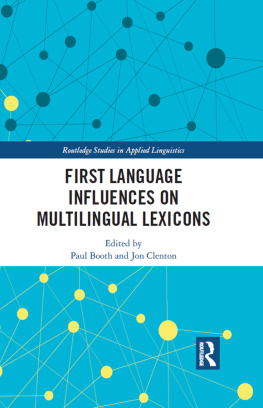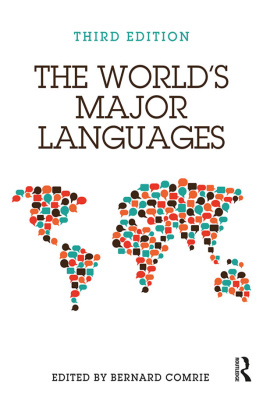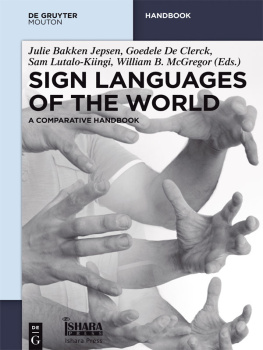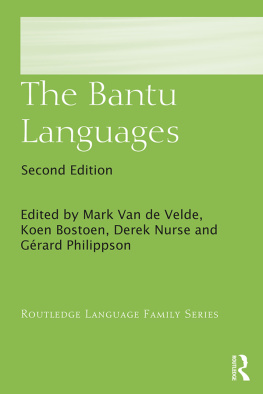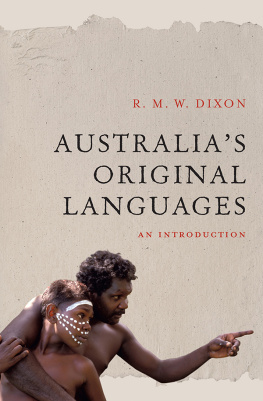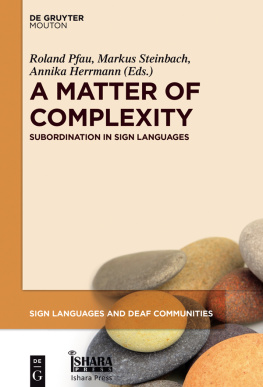Guide

Laura J. Downing and Annie Rialland (Eds.)
Intonation in African Tone Languages
Phonology and Phonetics

Editor
Aditi Lahiri
Volume 24

ISBN 978-3-11-048479-3
e-ISBN (PDF ) 978-3-11-050352-4
e-ISBN (EPUB) 978-3-11-049907-0
ISSN 1861-4191
Library of Congress Cataloging-in-Publication Data
A CIP catalog record for this book has been applied for at the Library of Congress.
Bibliographic information published by the Deutsche Nationalbibliothek
The Deutsche Nationalbibliothek lists this publication in the Deutsche Nationalbibliografie; detailed bibliographic data are available on the Internet at http://dnb.dnb.de.
2017 Walter de Gruyter GmbH, Berlin/Boston
Typesetting: RoyalStandard, Hong Kong
www.degruyter.com
Laura J. Downing and Annie Rialland
Introduction
Laura Downing , University of Gothenburg
Annie Rialland , Laboratory of Phonetics and Phonology, (CNRS) Paris
1Organization of the book
The twelve languages investigated in the studies in this volume represent different language families and are spoken in disparate regions of the African continent. The chapters are organized geographically, moving from north to south and west to east. The first chapter is thus on Moro (Kordofanian), spoken in the Nuba Mountains region of Sudan. The next five chapters discuss languages spoken in western Africa: both non-Bantu Knni (Gur, Ghana), Akan (Kwa, Ghana) and Mambila (Bantoid, Cameroon) and Bantu Basaa (A43, Cameroon) and Embosi (C25, Congo-Brazzaville).We move then roughly due east in the next two chapters, which discuss closely related eastern Bantu languages (with quite different prosodic systems): Chimiini (G42, formerly spoken in Somalia); and Shingazidja (G44a, Comoros Islands), both considered varieties of Swahili. The final three chapters discuss east central and southern Bantu languages: Bemba (M42, Zambia), Chichewa (N31) and Tumbuka (N21), both spoken in Malawi, and Tswana (S31, South Africa). Two of the languages Chimiini and Moro are endangered, and documenting their prosody is especially urgent. The selection of languages also represents a variety of prosodic systems, from highly tonal Mambila (with four level tone contrasts) to the restricted tone or tonal accent systems of Chimiini, Shingazidja and Tumbuka.
Each chapter contains a discussion of the complete prosodic system of the language(s) under investigation: tone and intonation and the interaction between the two. The authors were asked to investigate the prosody of particular constructions (declaratives, polar and content questions and focus constructions), and, if possible, dislocations and complex sentences. In analysing their data, the authors were asked to be attentive to register effects like downstep or pitch raising, to boundary tones and to evidence for different levels of prosodic phrasing. Within these guidelines, the authors were left free to take a more or less quantitative approach, though all were asked to provide pitch tracks of representative constructions. Sound files for the pitch tracks in each chapter can be found at the following link: http://dx.doi.org/10.1515/9783110503524.suppl. The authors were also left free to concentrate on the topics related to intonation that turned out to be most interesting for their particular language.
2Realization of intonation in tone languages
The contributions aim not only to broaden the descriptive base for intonation typology but also to test proposals about the way intonation can be realized in tone languages. Current textbooks on tone and/or intonation like Cruttenden (1997), Yip (2002) and Ladd (2008) survey the expected range of phonetic means for expressing intonation in tone languages, based on the scant existing literature. The consensus is that tonal languages can make use of: 1- pitch register raising or lowering (Cruttenden 1997, Yip 2002); 2- downdrift (downstep) and the suspension of downdrift (Cruttenden 1997, Yip 2002); 3- expansion or narrowing of the pitch range (Cruttenden 1997, Ladd 2008 and Yip 2002); 4- some kind of modification of the final tone of the utterance (Cruttenden 1997); or 5- boundary tones at domain edges or on the closest head (Yip 2002, Ladd 2008). The studies in this volume make particular contributions to our knowledge of the role of downtrends (i.e., downdrift, downstep, declination and final lowering), changes in register, and boundary tones, especially final boundary tones, in the intonation of tone languages.
2.1Downtrends
Within the field of prosody, the study of downtrends is almost a field in itself. Many articles have been devoted to downtrends, as well as lengthy book chapters (Ladd 1996, Gussenhoven 2004). While pioneering approaches analyzed downtrends as overall slopes (Cohen & tHart 1967, Delattre 1966, Grding 1982, for example), the field has made progress by decomposing the downtrends, differentiating the processes at work and providing a better characterization of them. Currently, the following processes are generally recognized as participating in the make up of downtrends:
1) Declination is a gradual downsloping of the fundamental frequency. Declination is more easily detectable in sequences of like tones (sequences of High as well as sequences of Low). Declination is generally considered as not being under phonological control.
2) Downdrift (or automatic downstep) is a progressive lowering of tone realisation in alternating High and Low tone sequences. It differs from declination, as it is not gradual. Since the seminal work of Liberman & Pierrehumbert (1984), it has been shown that its general shape is that of a decaying exponential to a non-zero asymptote. Phonetic studies have confirmed this shape for downdrift in many languages, including African languages such as: Igbo (Liberman et al. 1993), Dschang Bamileke (Bird 1994), Yoruba (Laniran & Clements 2003), Chichewa (Myers 1996), and Dagara (Rialland & Some 2011). Downdrift is often modeled with hierarchical structures, encoding the progression of the step-by-step lowering (Clements 1979, 1981; Ladd 1990).
3) Downstep (or non-automatic downstep) is a downward register shift of a tone, which extends also to the realisation of the following tones. Realisations of automatic downsteps (downdrift) and downstep can be similar or not within a given language; see Rialland & Some (2011) for a case study and an overview. Downstep can be triggered by a floating Low tone, or not. In some systems, downstep separates two adjacent High tones and is triggered by the OCP (Obligatory Contour Principle; see, e.g., Odden 1986; Yip 1988 for discussion).
4) Final lowering is an additional lowering at the end of an utterance (or a prosodic constituent). This final lowering can be partial or total (lowering of a High tone to the level of a Low). Its domain varies depending upon languages, from a single syllable to a phonological phrase.
5) Register compression/expansion or register lowering/raising are register modifications of the tonal realisations. They can have linguistic or paralinguistic functions. If they apply locally, as in register compression of the post-focus parts of an utterance, for example, they can modify the shape of the downtrend.
Understanding downtrends in a given language involves trying to find answers to questions such as the following: do the observed downtrends involve downdrift or declination? To what extent does the downtrend depend upon the sequences of tones involved? Is there final lowering? What is its nature and its extent? If there are downsteps, are they due to floating Low tones, or are they introduced to separate two consecutive High tones (as a consequence of an OCP effect)? Is downdrift realised similarly to downstep?

